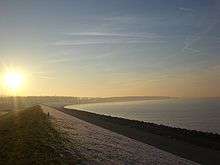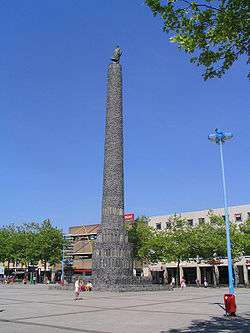Lelystad
| Lelystad | |||
|---|---|---|---|
| City and Municipality | |||
|
Lelystad city centre | |||
| |||
.svg.png) Location in Flevoland | |||
| Coordinates: 52°30′N 5°29′E / 52.500°N 5.483°ECoordinates: 52°30′N 5°29′E / 52.500°N 5.483°E | |||
| Country | Netherlands | ||
| Province | Flevoland | ||
| Established | 1 January 1980 | ||
| Government[1] | |||
| • Body | Municipal council | ||
| • Mayor | Margreet Horselenberg (PvdA) | ||
| Area[2] | |||
| • Total | 765.45 km2 (295.54 sq mi) | ||
| • Land | 231.54 km2 (89.40 sq mi) | ||
| • Water | 533.91 km2 (206.14 sq mi) | ||
| Elevation[3] | −3 m (−10 ft) | ||
| Population (May 2014)[4] | |||
| • Total | 76,285 | ||
| • Density | 329/km2 (850/sq mi) | ||
| Time zone | CET (UTC+1) | ||
| • Summer (DST) | CEST (UTC+2) | ||
| Postcode | 8200–8249 | ||
| Area code | 0320 | ||
| Website |
www | ||
Lelystad (Dutch: [ˈleːlistɑt]) is a municipality and a city in the centre of the Netherlands, and it is the capital of the province of Flevoland. The city, built on reclaimed land, was founded in 1967 and was named after Cornelis Lely, who engineered the Afsluitdijk, making the reclamation possible. Lelystad is approximately 3 metres (9.8 feet) below sea level.
History
Lelystad is built on the seabed of the former Zuiderzee. About 6500 years ago this wetland was above high tide level and inhabited; the Netherlands have steadily subsided since. Near Lelystad at Swifterbant, the oldest human skeletons in Western Europe were discovered. Due to rising water levels and storms, the peatlands were washed away, and the Lacus Flevo (in Roman times) grew to be the Almere (Middle Ages) and became the Zuiderzee. The Zuiderzee (Southern Sea) was the main transport route from Amsterdam to the North Sea and the Hanseatic League cities. Due to the many shipwrecks in Flevoland, Lelystad now houses the National Centre for Maritime History, with a museum and the shipyard that has built the Batavia replica.

After the Second World War the Zuiderzee Works continued, constructing the polder of Eastern Flevoland. In 1950 work commenced on several construction islands in the middle of the IJsselmeer. Lelystad-Haven was the largest island, and its wooden barracks housed a community of dyke-builders. In 1955 they reached the mainland, which made it possible to drive to Lelystad by car. One of the three pumping stations, which drained the polder in June 1957, was the diesel-powered Wortman in Lelystad-Haven. Until 1967 the only inhabitants of Lelystad were technical engineers and laborers and superintendents, living on the former construction island.
Landscape

Lelystad is the largest municipality in the Netherlands in area, but a large part of that area is water: Markermeer and IJsselmeer. Another major area is the internationally famous nature park of Oostvaardersplassen, which arose naturally when the polder of South Flevoland was drained. Lelystad is also surrounded by a square of woodlands and parks and flat farmland. The importance of the landscape and sky is emphasized by several pieces of land art: engineers' work and works such as the Observatorium by Robert Morris (see below).
Tourism
Lelystad has several tourist attractions, including:
- The replica of the 17th-century ship Batavia at the Batavia Shipyard.
- Batavia Stad Fashion Outlet (Batavia Stad Outlet expansion to the waterfront).
- Hanzestad Compagnie a fleet of historical sailing ships
- Lelystad Nature Park
- National Aviation Theme Park Aviodrome
- Modern architecture, for example the Zilverparkkade and Agora Theatre
Lelystad hosts many one-day events like the Lelystad Airshow, the Water Festival, the National Old Timer Day, Lelystad Speedway, Architecture day and several sports events. On the Midland Circuit many motor, kart and stock car racing events and several autoclub meetings are held. On the coast there are several marinas.
Transport
Lelystad has good infrastructure. Lelystad can be reached by air, water, and land.
- Air: Lelystad Airport is a small satellite of the national airport Schiphol. Although no regular flights between Schiphol and Lelystad Airport exist. Lelystad Airport will expand. In 2018 all holiday flights will leave/arrive from/on Lelystad Airport.
- Water: Lelystad has its own inland port, several marinas and canals that also help to manage the water levels in the polder. One of these lakes is called Zuigerplas, which means "Sucker-lake": it is so named because it is in a hollow that was made by a suction dredger taking sand from the wrong place; near it is a wood called Zuigerplasbos.
- Rail: the Weesp–Lelystad railway (Flevolijn) connects the city with Almere and Amsterdam. The Lelystad–Zwolle railway (Hanzelijn) connects Lelystad with Dronten, Kampen and Zwolle.
- Motorway: on the eastern side of Lelystad runs the A6 motorway from Amsterdam to the North. Through Lelystad the west-to-east N302 runs from Hoorn to Kootwijk.
Shield and flag

The honeycomb grid in the arms of Lelystad represents the dykes, built with six-edged concrete or basalt blocks. The colour gold indicates the high costs of the project of making the polder. The centre shield is the arms of engineer Cornelis Lely. The sealions reflect the history of the land.
In the flag, the fleur-de-lis (lily) again takes a central point, referring to the name Lely. The yellow (golden) background reflects the precious land, and the blue lines the dykes and waterways. The flag of the province is similarly adorned with the fleur-de-lis to commemorate Lely.
Future
The Zuiderzeelijn is a projected railway which could connect Lelystad with Emmeloord, Heerenveen and Groningen. In one variation the Zuiderzeelijn would be a magnetic levitation train line providing a faster connection between Amsterdam and Groningen. Another more realistic variation would be a conventional electrified train track allowing speeds up to 200 km/h.
Other plans for the near future include the development of the coastal area (Lelystad borders both the Markermeer and the IJsselmeer) for tourist and commercial purposes.
Notable residents
- Abraham Bueno de Mesquita (d. 2005), comedian and actor
- Rianne ten Haken, model
- Karin Ruckstuhl, former athlete
- Niels de Ruiter, professional darts player
- Ivan Sokolov, Bosnian chess master
- Co Stompé, professional darts player
- Jolijn van Valkengoed, swimmer
- Thijs van Valkengoed (born 1983), breaststroke swimmer
- Chiel Warners, former decathlete
- Boy Waterman, football goalkeeper
- Nathaniël Will, footballer
- Aron Winter, retired footballer, football manager
- Ruben Schaken, football player
References
- ↑ "Portefeuilleverdeling" [Tasks] (in Dutch). Gemeente Lelystad. Retrieved 1 September 2013.
- ↑ "Kerncijfers wijken en buurten" [Key figures for neighbourhoods]. CBS Statline (in Dutch). CBS. 2 July 2013. Retrieved 12 March 2014.
- ↑ "Postcodetool for 8232ZX". Actueel Hoogtebestand Nederland (in Dutch). Het Waterschapshuis. Retrieved 1 September 2013.
- ↑ "Bevolkingsontwikkeling; regio per maand" [Population growth; regions per month]. CBS Statline (in Dutch). CBS. 26 June 2014. Retrieved 24 July 2014.
External links
| Wikimedia Commons has media related to Lelystad. |
 Lelystad travel guide from Wikivoyage
Lelystad travel guide from Wikivoyage- Official website
 |
IJsselmeer |  | ||
| Markermeer | |
Dronten | ||
| ||||
| | ||||
| Almere | Zeewolde |


